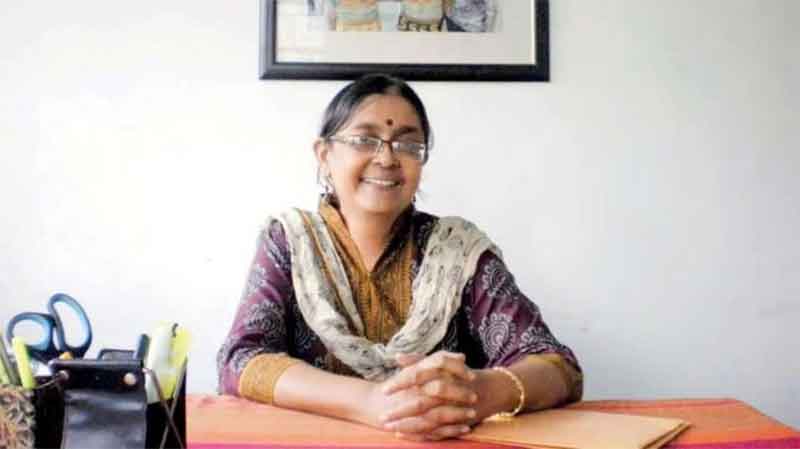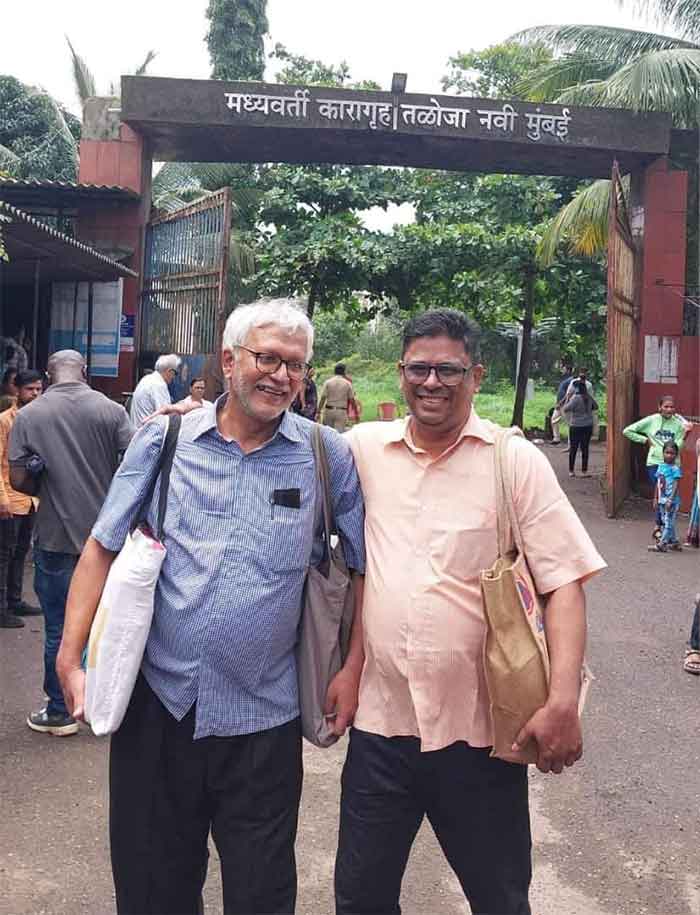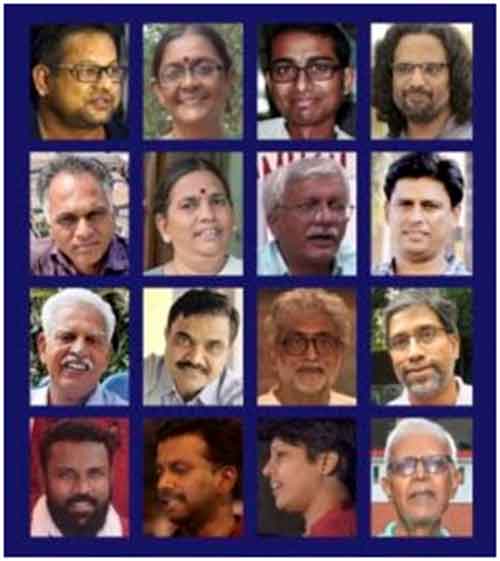
The NIA probe in the Bhima Koregaon case has revealed that mass mobilization of militant Dalit and Muslim forces is happening against the government. ‘According to NIA, the documents seized from (Rona) Wilson mentioned that Dalits and Muslims must come together to build a major anti-fascist front in the Indian subcontinent as soon as possible.’ These documents are evidence against Dalits and a proof of their anti-national activities in the context of Bhima Koregaon. They are also proof against Muslim students and activists who have been arrested on charges of sedition and inciting violence in the context of the NRC-CAA protests.
These documents proving the anti-nationalism of Dalits and Muslims come at a time when a special court declared the innocence of those who destroyed the Babri Masjid. While the court said the demolition of the Babri Masjid by Hindus was unplanned, various investigative agencies are alleging that both the Bhima Koregaon violence and the Delhi riots were meticulously planned by Dalits and Muslims respectively. Hindu assertion, even after it was proven to be violent, is innocent because it is unplanned. Dalit and Muslim assertion, even though unproven to be violent, makes them guilty because it is planned. While spontaneous violence is being eulogized as natural Hindu pride, planned assertion by non-Hindus of their fundamental rights is being criminalized.
Why is the government so afraid of Dalits and Muslims coming together? Dalits and Muslims are the poorest communities in India with the least amount of people in positions of power. They barely have any land or any other form of capital. These two groups don’t even have any territory they can claim to form a country of their own apart from India, unlike the Adivasis, Punjabis, Kashmiris, Nagas, Manipuris, etc. All they want are equal citizenship rights in India. That should be a matter of course in a modern democracy, no? Apparently not.
The impossibility of us
I am 29, unmarried, and with no marriage prospects in sight. This might not sound abnormal but it is in my family where men are supposed to get married latest by 26, a number that has been arrived at based on the sanatan principles of Jain science. My family is very concerned about whether I will get married, and if I do, then to whom I will get married. They are afraid I will marry an atheist who won’t have the decency to learn the Namokara Mantra, let alone the Bhaktamar Stotra. Their first preference is that I marry a Jain girl but, having educated me, they know that they can’t actually force me to marry a girl of their choosing. I am an ungrateful wretch (morally independent) who can get a job (economically independent) due to the social capital they themselves have bequeathed to me. Thus, they want to reach a compromise. They say that if I don’t want to marry a Jain girl, I don’t have to, they respect my decision. At the same time, I must respect their wishes too to some extent. What are their wishes? I can marry a girl from any community except Dalits and Muslims. This isn’t due to any antipathy to the two communities, my parents say, but merely due to practical considerations. All other Indians (read Hindus) can ‘fit’ in a Jain family but the Dalits and Muslims are so different that there is no scope for assimilation at all.
My family does not operate in a vacuum. It gets its cues from the society it lives in. If we see the family as a microcosm of the nation, then we can see how my casteist family represents the ideas of the caste republic that is India. That my parents refuse to let me marry a Dalit or Muslim girl because she won’t be able to assimilate into our family represents the larger notion that Hindus hold of the inability of Dalits and Muslims to assimilate into the Indian nation. What does this lack of assimilation mean? It is not that Dalits and Muslims are physically being thrown out of India; though there are fledgling attempts to put them in camps, no one has yet seriously argued that all Dalits and Muslims should leave India. The lack of assimilation means that Dalits and Muslims cannot be part of the governing class. Dalits and Muslims can fit into my home as servants but they cannot fit into it as owners; they can be in the country as the governed but they cannot be in it as the governors. If the governing class is composed of Hindus who keep power confined within their families, then the interdiction on inter-caste marriage is an important way of keeping undesirables out of the family and out of power. Property, which is the primary source of power today, can be kept confined to Hindus only if they refuse to marry Dalits and Muslims.
Dalits and Muslims, who do not have any similarity with each other prima facie, are in an analogous situation in India. They see themselves as being trapped within the Indian state. They are sparsely distributed across the country and thus surrounded on all sides by Hindus. They cannot leave the country and form another nation-state but they also can’t live here peacefully because the Hindus won’t let them. They are constantly attacked by Hindus for as little as asserting their right ‘to swagger and swear and waste’. They are kept in poverty by being discriminated against in government employment and in the market. They are treated as second-class citizens overall. Any assertion by Dalits and Muslims is termed communalism and anti-national by the Hindus who claim the right to hold power as the only national community.
Muslims and Dalits logically have a common cause as they are being discriminated against by a common enemy. This logical unity imposed upon Muslims and Dalits by the Hindus has always been a source of dread and anxiety for the Hindus themselves. The prospect of Dalit-Muslim unity has always terrorized the Hindu and puts fear in the heart of the Hindu to this day. The Hindu-dominated Indian government is afraid of Muslims and Dalits for the only thing they have been given in a liberal democracy, one man one vote. If Dalits and Muslims come together and refuse to vote for Hindus, the hold of Hindus on parliament becomes difficult to maintain.
Gandhi, my father
Confucius, who understood a thing or two about statecraft, argued that the sovereign is to be seen as the father of the nation. Like a child owes obedience to their father, so we owe obedience to the sovereign. It is in this context that we must understand the significance of Gandhi. His being proclaimed the father of the Indian nation was not an empty PR stunt. Gandhi really is the father of Hindu rule in India and he must be obeyed by every Hindu if they want to keep their dominance intact. As a Lutheran par excellence, Gandhi knew how Hinduism ought to be re-formed to survive the demands of modernity. He was in touch with all the problems that Hindus could face as rulers of modern India and vied to give solutions for those problems.
The greatest threat to Hindu rule in a majoritarian democracy comes from Hindus losing their numerical dominance. This problem was diagnosed by Gandhi when the untouchables under the leadership of Dr Ambedkar demanded separate electorates. The demand was based on the fact the untouchables who were not Hindus and were discriminated against by the Hindus should also get the same safeguards as the Muslims, who had been awarded separate electorates earlier. Not only did Gandhi invent the epic fast in response to this demand by the untouchables, he was also alarmed enough to clearly state his fears—
‘If untouchables do not fall as Hindus, then it will lead to bloodshed. Untouchable hooligans will make common cause with Muslim hooligans and kill caste Hindus’ – Collected Works of Mahatma Gandhi, Vol. 50 (469)
The Hindu fear of Dalit-Muslim unity expressed by the NIA is not new, it is at least a hundred year old fear passed on to today’s Hindus by their father. Separate electorates were not just a problem between the untouchables and the Hindus. They were a problem between three parties. They were a problem because they could lead to Dalit-Muslim unity against the caste Hindus. Gandhi did not care about the inclusion of untouchables in Hinduism till the prospect of Dalit-Muslim unity became real and threatened the numerical superiority of Hindus in the electorate. Once he saw that prospect, he became adamant that untouchables had to absolutely be counted as Hindus. The inclusion of untouchables into Hinduism was a ploy by Gandhi to separate them from the Muslims.
If Dalits chose their own leaders through separate electorates, then there would be nothing stopping those leaders from making alliances with Muslims to keep the Hindu majority in check. The only way to stop such alliances would be to disallow the Dalits from choosing their own leaders. This is why Gandhi allowed reservations for Dalits in Parliament but did not allow separate electorates for them. Only those Dalits were able to get elected who had support from the Hindus. Independent leaders who could make alliances with Muslim parties lost to Dalits sponsored by the Congress which disallowed any such alliances. This has continued after the transfer of power as only those Dalits are elected to parliament on reserved seats who are willing to become chamchas, in Kashi Ram’s words, of the Hindus.
Ambedkar pointed out that Gandhi presented different and often contradictory views in the magazines that he ran in English and Gujarati. While he presented an anti-caste face in the English magazine which was meant for foreign readers, he fully supported caste in the Gujarati magazine which was meant for Hindus in India. He claimed to be the leader of the masses on the one hand while he acted as the leader of the Hindus on the other. Ambedkar said that the Mahatma treated truth as so much malleable material to be shaped selectively according to the audience he was addressing.
The father of the nation has also taught this double dealing with truth to his Hindu sons. When the Muslims raise the problem of caste in Hinduism, Hindus say that caste also exists among Muslims and they shouldn’t cast aspersions on Hindus without solving the problem in their own community. But when untouchable Muslims demand to be recognized as scheduled castes, the Hindus say that there is no caste in Muslims as caste is a solely Hindu phenomenon (the Supreme Court declared as much in 1956).
It is in this light that Gandhi’s pigheaded insistence on Hindu-Muslim unity must be understood. Gandhi’s Hindu-Muslim unity created the fiction that there was a united pan-Indian Hindu community and a united pan-Indian Muslim community which could be represented by upper-caste Hindu and Muslim leaders respectively. The demand for Pakistan was rejected by lower caste Muslims because they did not want to live in a state dominated by upper caste Muslims. This rejection was analogous to the rejection of a hasty swaraj by the Dalits who did not want to live in a Hindu raj. Gandhi refused to see the caste differences in Muslims only because he did not want to see the caste differences in Hindus. The call for Hindu-Muslim unity was not so much to establish unity between Hindus and Muslims as it was to establish unity among Hindus and among Muslims.
The refusal to recognize caste in Muslims is also part and parcel of keeping Dalit and Muslim mobilizations separate. The President’s Constitution (Scheduled Castes) Order No. 19 of 1950 categorically declared that ‘no person who professes a religion different from the Hindu religion shall be deemed to be a member of scheduled caste’. While this was amended in 1956 to include Sikhs and in 1990 to include Buddhists, Dalits can only convert to Islam at the cost of losing the benefits of affirmative action that are due to them.
Back to the future
The liberal state led by Congress makes Dalits accept Hinduism by making the benefits of affirmative action dependent on this acceptance. Then, the BJP comes along and uses this Hindu identity to get votes for its Hindu agenda. On the one hand, Dalits are used by Hindus to attack Muslims (Dalits were present in large numbers in the demolition of the Babri Masjid). On the other hand, Dalits are discriminated against in the Muslim-free India being made by Hindus (no Dalit is allowed to assume priesthood in the newly minted Ram Mandir). While the Hindu agenda is overtly against Muslims, it is also against Dalits as Hinduism itself is nothing but Brahminism and a Hindu agenda can be nothing but Brahminical.
Calls for Dalit-Muslim unity have increased since both Dalits and Muslims are being lynched on the streets and in their homes for eating beef, getting married to a Hindu, or asserting right over land and resources that legally belong to them anyway. Hindu fascism treats Dalit-Muslim unity and assertion as dangerous because the unity of Hindus is predicated on the hatred of Muslims on the one hand and the serfdom of Dalits on the other. Fear of Muslims and contempt of Dalits are the twin principles of a united Hinduism. Hinduism has no core to stabilize around, no religious book, no particular god, not even an agreed upon definition. Since Hindus are completely dependent on Dalits and Muslims for their unity, when Dalits and Muslims don’t behave as the Hindus require them to behave, Hindus start lashing out.
Muslims have to be made into terrorists because it is the fear of Muslims that makes Hindus band together as Hindus. The Muslim is the foil that allows Hindus to understand their Hinduness and assert it. The differences between the thousand and one sects of Hinduism can only be overcome if there is a Muslim to contrast themselves with. A Hindu is more than anything else a non-Muslim. The Dalit is important because the Hindu order can only survive if there are people who can be made to do the ‘dirty’ work and humiliated in the process thus becoming inferior in relation to all other Hindus who become united in superiority. The unity in superiority of Hindus can only be asserted on the backs of Dalits. Without the caste order, there is nothing called Hinduism, and the caste order can only survive if Dalits continue to be untouchables.
If Muslims try to break free by themselves, then the Dalits will be used against them. If Dalits try to break free, then the fear of Muslims will be used to put the Dalits in line. Hindus can only be dominant as long as they play Dalits and Muslims against each other by continually asserting that Dalits are Hindus and Muslims are foreigners. Divide and rule, some ironists might say. For a united stand against Hinduism, Dalits have to renounce Hinduism and claim that being non-Hindu is as much native to India as being Hindu is, by which token Muslims are no less Indian than anyone else. This is what Iyothee Thass and Ambedkar did when they renounced Hinduism and adopted Buddhism.
It is as part of this movement against Hindu fascism that Chandrashekhar Azad called an anti-NRC/CAA protest at Jama Masjid in Delhi to proclaim that Dalits and Muslims were coming together and standing up for each other. The gesture did not go unnoticed by the Hindu establishment. That is why the government has stepped up its attack on Dalits and Muslims through such farcical evidence as the documents found by NIA with Rona Wilson. Dalit and Muslim unity is being treated as criminal because this unity is the only way of dislodging the Hindus from their position as the sanatan ruling class. The Hindus know this and are thus mortally afraid of this unity actually materializing. As the rulers of the nation, they thus designate it anti-national.
Akshat Jain is a writer currently residing in India. He uses the debate methodology of Syādvāda to piss people off. Like a good Syādvādist, he claims that all his claims fall within the ambit of falsifiability.
SIGN UP FOR COUNTERCURRENTS DAILY NEWSLETTER














































